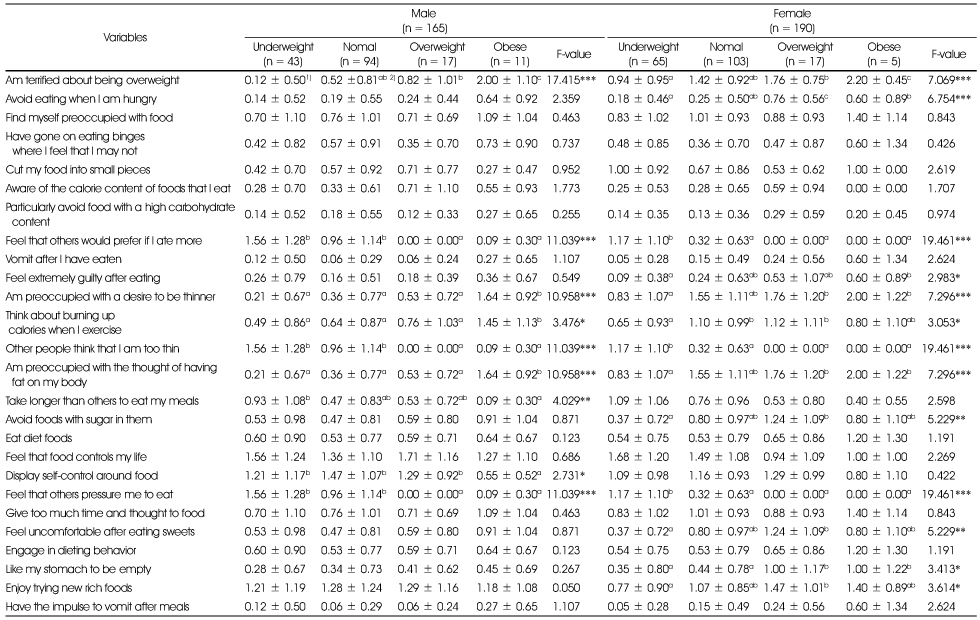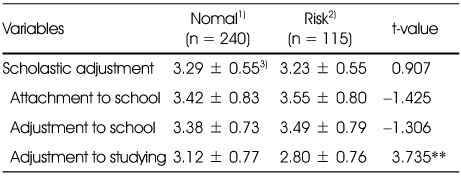References
1. Bae JH, Choi JY. A study on psychological characteristics of eating disorders: A comparision with restrained, unrestrained (normal) eaters, and overweighters. Korean J Clin Psychol 1997. 16(2)209–217.
2. Cho MB. A study on the effects of eating behaviors and personality characteristics on Academic adaptation for higher grade elementary school students in certain regions of Busan 2008. Kosin University; 42–43.
MS thesis.
3. Choe JS, Chun HK, Chung GJ, Nam HJ. Relations between the dietary habit and academic achievement, subjective health judgement, physical status of high school students. J Korean Soc Food Sci Nutr 2003. 32(4)627–635.
4. Choi JH, Ahn DH, Nam JH, Cho YG, Choi BY. Reliability testing of eating attitude test for Korean adolescents. J Child Adolesc Psychiatry 1998. 9(1)91–97.
5. Choi MK, Kim MH, Lee YS, Cho HK, Kim KH, Lee BB, Sung MK, Sung CJ. Relation between obesity indices and, nutritional knowledge, nutritional status and blood parameters in obese middle-school students. J Korean Soc Food Sci Nutr 2005. 34(2)181–189.
6. Garner DM, Olmsted MP, Bour Y, Garfinkel PE. The eating attitudes test : Psychometric features and clinical correlates. Psychol Med 1982. 12871–878.
7. Ha JS, Lee HG. Effect of middle-school students' food behavior on health condition and degree of study accomplishment. J Korean Home Econ Assoc 1995. 33(3)225–242.
8. Hancox RJ, Milne BJ, Poulton R. Association between child and adolescent television viewing and adult health: a longitudinal birth cohort study. Lancet 2004. 364(9430)257–262.
9. Kang MH, Choue RW. Relationships of body image, body stress and eating attitude, and dietary quality in middle school girls based on their BMI. Korean J Nutr 2010. 43(3)285–293.
10. Kim HH, Ro HK. A study on middle school students of Gwangu · Chonnam in terms of dietary life, dietary relates self-efficacy according to body mass index. Korean J Community Nutr 2009. 14(5)483–494.
11. Kim JH. Study on the physique status and eating disorder behavior among high school students in Daejeon. J Korean Home Econ Educ Assoc 2002. 16(3)115–129.
12. Kim KH, Yang KM. The relationship between eating disorders and parent-adolescent communication in middle school students in rural areas. J Korean Acad Nurs 2008. 38(1)55–63.
13. Kim SA, Lee BH. Relationships between the nutrient intake status, dietary habits, academic stress and academic achievement in the elementary school children in Bucheon-si. Korean J Nutr 2008. 41(8)786–796.
14. Kim SH. Children's growth and school performance in relation to breakfast. J Korean Diet Assoc 1999. 5(2)215–224.
15. Kim SN. A causal analysis among variables related to juvenile delinquency 1994. Chonnam National University; 30–128.
Dissertation.
16. Kwak SR. The adolescents' school adjustments to academic performances: a longitudinal study. Korean J Sociol Educ 2008. 18(1)1–20.
17. Lee HY, Kim HW. Current status and explanatory variables of eating problem among female middle school students. Korean J Youth Stud 2011. 18(5)413–433.
18. Lee JE, Cho MH. Impact of family, shool and neighborhood factors on youth school adjustment. Stud Korean Youth 2007. 18(3)79–102.
19. Rierdan J, Koff E. Weight, weight-related aspects of body image, and depression in early adolescent girls. Adolescence 1997. 32(127)615–624.
20. Sung MH. Relationship between eating disorders physical symptoms, depression and health locus of control among elementary school girls in South Korea. J Korean Acad Nurs 2004. 34(3)576–585.
21. WHO Western Pacific Region. The Asia-Pacific perspective: redefining obesity and its treatment 2000.
22. Yim KS. Effects of obesity, body image dissatisfaction and dietary habits on the risk of disturbed eating attitudes among high school students in Gyunggi province, Korea. Korean J Community Nutr 2010. 15(5)656–669.





